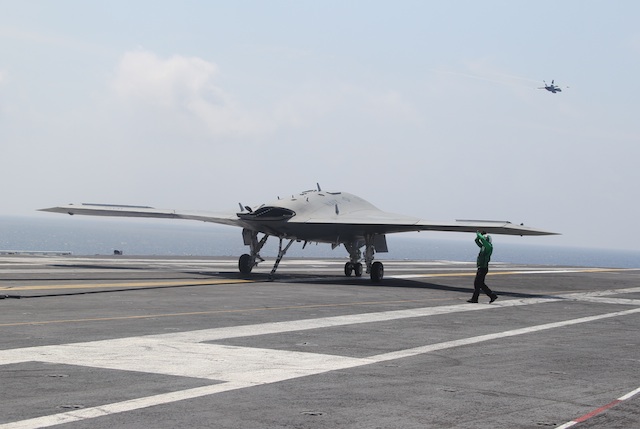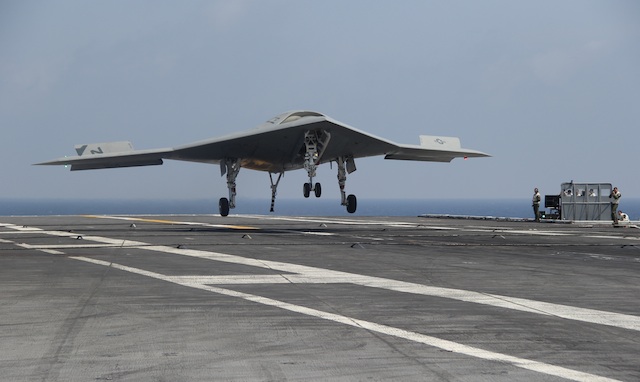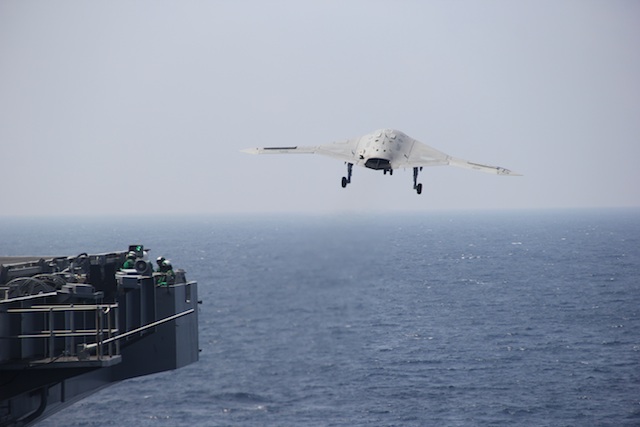Two aircraft – an unmanned Northrop Grumman X-47B and the Boeing F/A-18C Hornet – launched and landed on the USS Theodore Roosevelt multiple times on 17 and 18 August, validating a decade-long, on-and-off quest to prove such a pairing is possible on a carrier deck.
Operating fixed-wing unmanned aircraft side-by-by side with manned fighters from a carrier deck was first conceived with the US Navy’s short-lived mid-range endurance programme of the late-1990s. The challenge was then passed to the Defense Advanced Research Projects Agency, but the joint unmanned combat air systems programme was cancelled in 2006.
Eight years later with more than $1.5 billion spent, the navy finally operated a Hornet and Northrop’s cranked-kite unmanned air vehicle aboard the Roosevelt – the graduation exercise of the unmanned combat air systems-demonstration (UCAS-D) programme.
“What you saw today was history – history in the making,” said Rear Adm Mathias Winter, programme executive officer of Naval Air Systems Command (NAVAIR), addressing a group of reporters who witnessed the first catapult and trap of manned and unmanned aircraft.

With the demonstration now largely complete, the navy is poised now to take the next step. The competitive phase of an acquisition programme estimated to cost between $3-$6 billion could begin by mid-September, Winter says.
The unmanned carrier launched airborne surveillance and strike (UCLASS) programme will solicit bids from Boeing, General Atomics Aeronautics Systems, Lockheed Martin and Northrop, with the goal of developing a carrier-based, tailless, unmanned aircraft that can evade radar, collect intelligence and launch weapons.
The Defense Acquisition Board – a panel of senior US military and civilian leaders – has a meeting scheduled on 10 September, Winter says. Their authorization will allow NAVAIR to release the request for proposals, with bids due in 60 days, he says.
As one of the few new weapons acquisition programmes available for bidding, UCLASS has received great attention from inside and outside the military. As an all-new capability with no manned equivalent in operation today, UCLASS also has invited controversy, with industry officials, the intelligence community, naval aviators and Congress expressing a diverse range of opinions over how such a system should be operated.

Several key aspects of the UCLASS force remain unknown. Winter acknowledges the navy does not know if the UCLASS fleet will operate as a standalone unit or as an adjunct to a manned fighter squadron or a detachment of Northrop E-2D Hawkeyes.
On the other hand, Winter emphasises that operational requirements for the UCLASS aircraft have remained stable despite the uncertainty and controversy. The bidders will be asked to design an aircraft that can take-off from a carrier and maintain a constant surveillance orbit up to 600nm (1,110km) away.
More controversially, the navy has diluted the penetrating capability of the UCLASS fleet. The selected aircraft will be required to operate in unchallenged airspace, with the capability to “grow” into a long-range, stealthy, penetrating aircraft, Winter says.
The two X-47Bs used in the UCAS-D programme were never intended to serve in an operational role, but the navy is trying to keep it beyond the demonstration. One option under review is to add the X-47Bs to the VX-23 squadron, the navy’s flight test unit, Winter says. If approved, the move would allow the aircraft to serve as testbeds for new technologies in development by NAVAIR or other research and acquisition centers, he says.
Until then, the X-47Bs may still have a role to play in the UCAS-D programme. The navy has not determined whether it needs a sixth carrier deployment next year to collect more data.

Winter described the demonstration on 17-18 August as a “floating laboratory” that presented unique challenges. In fact, the X-47B assigned to perform the demonstration took off from NAS Patuxent River in Maryland early on 17 August, but had to turn back because of a fuel pump failure.
The back-up aircraft was already onboard the Roosevelt’s deck, but its initial launch off the carrier was delayed. As the nose-wheel was moved into the shuttle connecting the aircraft to the ship’s steam-driven catapult, the deck angle off the ship was measured as slightly negative, meaning the aircraft may not generate enough lift to get airborne after leaving the deck.
The ship’s captain pumped fuel aft and re-arranged hardware in the hangar bay, allowing the bow of the ship’s deck to return to level.
In all, the two X-47Bs completed three of four planned testing periods over the two-day period, according to the navy.
(Photos by Stephen Trimble)
Source: FlightGlobal.com











































